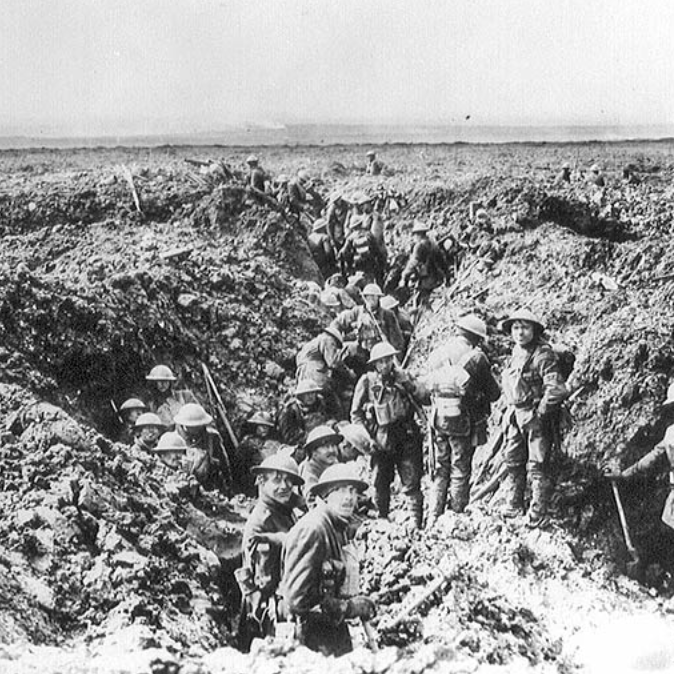Lauren Roulston • Apr 9, 2024

Canadians consolidating their positions on Vimy Ridge, Apr 1917 (Library and Archives Canada).
The Battle of Vimy Ridge began 107 years ago on this day. It was a rainy Easter morning at 5:30 a.m. when all four Canadian divisions attacked together in Northern France.
Over 15,000 Canadian infantry overran the Germans through the sleet, mud, and shellfire.
Soldiers from all across the country were present, and over 10,000 ended up killed or wounded. Today, Canadians are remembering the countless acts of sacrifice that came from this battle.
Prime Minister Justin Trudeau issued a statement this morning. “Today, we remember the bravery and sacrifices of the Canadian soldiers who fought for peace, freedom, and justice in the Battle of Vimy Ridge,” he writes.
“Canada’s success at Vimy Ridge marked one of the First World War’s most memorable victories, but victory came at a heavy cost,” he adds.
3,598 are said to have been killed at Vimy, a battle celebrated as the moment Canada became a nation and earned itself a seat at the Versailles Peace Treaty.
The Canadians seized the heavily fortified seven-kilometre ridge from the Germans, earning a reputation as formidable and effective troops. Previous attempts from the French military had failed, with over 100,000 casualties.
The Vimy Foundation writes that Apr. 9, 1917 is still the bloodiest day in Canadian military history.
Governor General Mary Simon is encouraging Canadians to reflect on the significance of this day and the stories of the soldiers who fought in battle.
“Learn the stories of the Indigenous soldiers who fought at Vimy, such as those who served with the 107th ‘Timber Wolf’ Battalion,” she writes in a statement issued today. “Or the story of Private Robert Gilbert and other Black Canadians who fought at Vimy Ridge.”
She names Ethelbert “Curley” Christian, who was serving with the 78th Canadian Infantry Battalion, the Winnipeg Grenadiers, during the Battle of Vimy Ridge. He was assigned to deliver supplies to the frontline trenches when heavy artillery-fire buried him in a trench under dirt and debris.

A Mural of Honour painting of Ethelbert “Curley” Christian (The Military Museums).
Christian was trapped there for two days with his limbs crushed. He was found barely alive, and the stretcher-bearers were killed by enemy fire while carrying him to safety.
Military records show that doctors decided to amputate his four limbs on account of gangrene. This procedure was unheard of at the time and incredibly risky.
Curley Christian became the first and only person to survive a quadruple amputation during the First World War. He received artificial limbs after the war and became an inspiration to Veterans and amputees across the country.
With his wife and the support of his medical team, he helped lay the foundation for what would later become a Canadian Forces financial and social assistance program for disabled Veterans, which is still offered today.
In 1922, a grateful French government granted Vimy Ridge and the land around it to Canada. Hill 145 is the highest and most important feature of the Ridge, and now the Canadian National Vimy Memorial sits atop it.
The gleaming white marble sculpture shows two pylons that represent Canada and France. They rise 27 metres above the base of the monument above a now quiet countryside.

The unveiling of Canada’s National Memorial at Vimy Ridge (Library and Archives Canada).
The names of all 11,285 Canadian soldiers listed as missing or presumed dead in France during WWI are inscribed on the monument.
The iconic memorial was designed by Toronto-born sculptor Walter Seymour Allward. He’s also got a statue of Robert Baldwin and Louis-Hippolyte Lafontaine on Parliament Hill in Ottawa.

(D. Gordon E. Robertson/Creative Commons).
Curly Christian was among many of the Veterans and amputees who attended the unveiling of the Canadian National Vimy Memorial in 1936.
“There are many other stories that represent our diverse country, I encourage you to learn about them,” says the Governor General. “We owe that much to the Canadians who were at Vimy Ridge more than a century ago, as well as to their families, who also sacrificed.”
